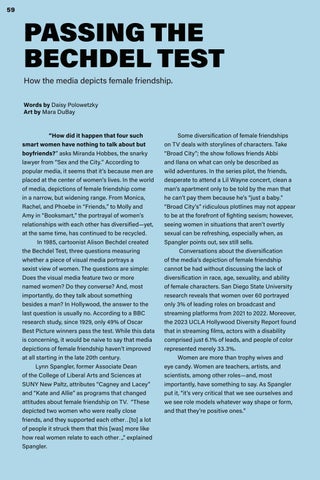59
PASSING THE PACKAGE 5 BECHDEL TEST Dek
Words Name depicts female friendship. How the by media Art by Name
Words by Daisy Polowetzky Art by Mara DuBay
“How did it happen that four such smart women have nothing to talk about but boyfriends?” asks Miranda Hobbes, the snarky lawyer from “Sex and the City.” According to popular media, it seems that it’s because men are placed at the center of women’s lives. In the world of media, depictions of female friendship come in a narrow, but widening range. From Monica, Rachel, and Phoebe in “Friends,” to Molly and Amy in “Booksmart,” the portrayal of women’s relationships with each other has diversified—yet, at the same time, has continued to be recycled. In 1985, cartoonist Alison Bechdel created the Bechdel Test, three questions measuring whether a piece of visual media portrays a sexist view of women. The questions are simple: Does the visual media feature two or more named women? Do they converse? And, most importantly, do they talk about something besides a man? In Hollywood, the answer to the last question is usually no. According to a BBC research study, since 1929, only 49% of Oscar Best Picture winners pass the test. While this data is concerning, it would be naive to say that media depictions of female friendship haven’t improved at all starting in the late 20th century. Lynn Spangler, former Associate Dean of the College of Liberal Arts and Sciences at SUNY New Paltz, attributes “Cagney and Lacey” and “Kate and Allie” as programs that changed attitudes about female friendship on TV. “These depicted two women who were really close friends, and they supported each other… [to] a lot of people it struck them that this [was] more like how real women relate to each other…,” explained Spangler.
Some diversification of female friendships on TV deals with storylines of characters. Take “Broad City”; the show follows friends Abbi and Ilana on what can only be described as wild adventures. In the series pilot, the friends, desperate to attend a Lil Wayne concert, clean a man’s apartment only to be told by the man that he can’t pay them because he’s “just a baby.” “Broad City’s” ridiculous plotlines may not appear to be at the forefront of fighting sexism; however, seeing women in situations that aren’t overtly sexual can be refreshing, especially when, as Spangler points out, sex still sells. Conversations about the diversification of the media’s depiction of female friendship cannot be had without discussing the lack of diversification in race, age, sexuality, and ability of female characters. San Diego State University research reveals that women over 60 portrayed only 3% of leading roles on broadcast and streaming platforms from 2021 to 2022. Moreover, the 2023 UCLA Hollywood Diversity Report found that in streaming films, actors with a disability comprised just 6.1% of leads, and people of color represented merely 33.3%. Women are more than trophy wives and eye candy. Women are teachers, artists, and scientists, among other roles—and, most importantly, have something to say. As Spangler put it, “it’s very critical that we see ourselves and we see role models whatever way shape or form, and that they’re positive ones.”
